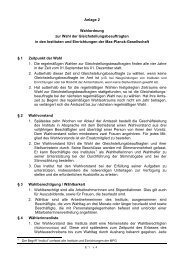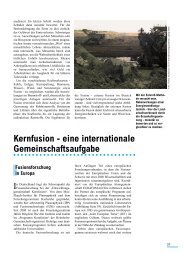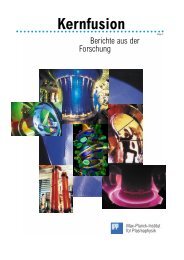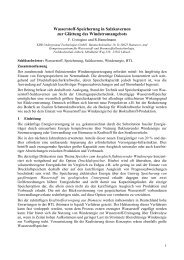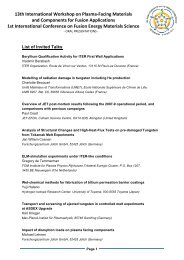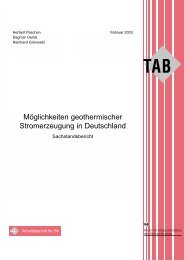IPP Annual Report 2007 - Max-Planck-Institut für Plasmaphysik ...
IPP Annual Report 2007 - Max-Planck-Institut für Plasmaphysik ...
IPP Annual Report 2007 - Max-Planck-Institut für Plasmaphysik ...
Create successful ePaper yourself
Turn your PDF publications into a flip-book with our unique Google optimized e-Paper software.
3D Analysis of Impurity Transport and Radiation for ITER Limiter<br />
Start-up Configurations<br />
Three-dimensional modelling of ITER SOL transport during<br />
the start-up limiter phase with the EMC3-EIRENE code has<br />
been extended to include the limiter-released Be production,<br />
transport and radiation. The distributions of the single Be<br />
charge-state densities and line radiation have been simulated<br />
for two plasma densities =0.2 n G , 0.5 n G and three plasma<br />
configurations, I p =2.5, 4.5, 6.5 MA. All Be charge states<br />
exhibit a strong poloidal density modulation due to the small<br />
poloidal extension of the limiters.<br />
Diagnostics<br />
ITER Procurement Package 21<br />
In January <strong>2007</strong> a consortium of the Euratom Fusion<br />
Associations (<strong>IPP</strong>, HAS, FZK, CEA and CIEMAT) under<br />
the leadership of <strong>IPP</strong> began work on the task of providing a<br />
project plan for the full development of ITER Procurement<br />
Package 21 (PP21). PP21 consists mainly of the bolometer<br />
diagnostic and the pressure-gauge diagnostic, but also of all<br />
diagnostic hardware associated with lower port 16, including<br />
that of other “client” diagnostics.<br />
The project plan contains a definition of the scope of PP21,<br />
of the work breakdown structure (WBS), the WBS dictionary,<br />
an implementation schedule and management plans for<br />
risk, procurement, communication, costs and quality. The<br />
project plan developed by <strong>IPP</strong> concentrates on the needs of<br />
the bolometer diagnostic and the port engineering activities.<br />
Aspects of the project plan concerning the pressure gauge<br />
diagnostic are the responsibility of CIEMAT.<br />
HAS contributes with the performance analysis of the system<br />
and the finite element analysis of the thermal behaviour of<br />
bolometer mini-cameras. FZK has made its experience in the<br />
nuclear analysis of the ITER environment available for the<br />
analysis of nuclear heat loads on models of mini-cameras.<br />
CEA contributed with its experience on various bolometer<br />
detector concepts and on irradiation tests. In addition to providing<br />
the project leader, <strong>IPP</strong> provided the lead engineer and<br />
contributed with research activities on the metal-resistor<br />
bolometer detector and to the integration of the diagnostic<br />
into the ITER CODAC system. In order to develop the project<br />
plan and to provide urgently needed data for the integration<br />
of the diagnostic in ITER, a number of R&D and engineering<br />
tasks had to be carried out in parallel to developing the project<br />
plan. The ongoing research activities on the reference metalresistor<br />
bolometer detector were continued and a prototype<br />
with a 4 μm Pt absorber was successfully tested in ASDEX<br />
Upgrade. Irradiation tests are in preparation as are the contracts<br />
with a new cooperation partner for the development of<br />
thin-foil detectors with 12 μm absorbers.<br />
In April a proposal for the LOS distribution was submitted<br />
to ITER. This was further refined in order to account for the<br />
ITER Cooperation Project<br />
67<br />
changes following the ITER design review. Based on this distribution,<br />
an initial performance analysis of the diagnostic was<br />
made. A preliminary ITER bolometer mini-camera and collimator<br />
were designed and adapted to all locations in the divertor<br />
cassettes (an example for divertor cassette 45 is given in<br />
figure 3) and to some in the VV, thus giving the basic definitions<br />
of the interfaces for the integration of the bolometer diagnostic.<br />
Figure 3: Distribution of mini-cameras as foreseen for the locations in<br />
divertor cassette 45<br />
The mini-camera/collimator model was analysed for its thermal<br />
behaviour in the divertor and behind the inner heat shield<br />
under conditions expected for the ITER standard scenario 2.<br />
The results showed that the mini-cameras should be able to<br />
cope with the demanding boundary conditions if sufficient<br />
thermal contact to actively cooled structures can be provided.<br />
In-Vessel Neutral Pressure Measurement<br />
The ASDEX Pressure Gauge (APG) is, at present, the main<br />
candidate for in-vessel neutral pressure measurement in<br />
ITER. The response of conventional APGs is found to saturate<br />
at around 15 Pa, below the ITER requirement of 20 Pa.<br />
With small modifications to the gauge geometry and potential<br />
settings, however, it is possible to obtain monotonic output<br />
with sufficient slope up to the maximum achievable pressure<br />
of 30 Pa at 6 T. The improved pressure range is achieved at<br />
the expense of a lower sensitivity and a somewhat stronger<br />
dependence on the magnetic field.<br />
Test of a Compact Soft X-Ray Spectrometer<br />
A prototype of a compact SXR spectrometer for ITER has<br />
been designed at the Kurchatov <strong>Institut</strong>e in Moscow and is<br />
presently being tested in ASDEX Upgrade. At present, one<br />
spectrometer channel is equipped with a crystal made of<br />
high purity quartz and a deeply depleted back illuminated<br />
CCD camera chip for radiation hardness. The spectrometer<br />
is set to monitor the resonance line of He-like argon. Due to the<br />
large diffraction angle used (≈70°), a high resolving power






